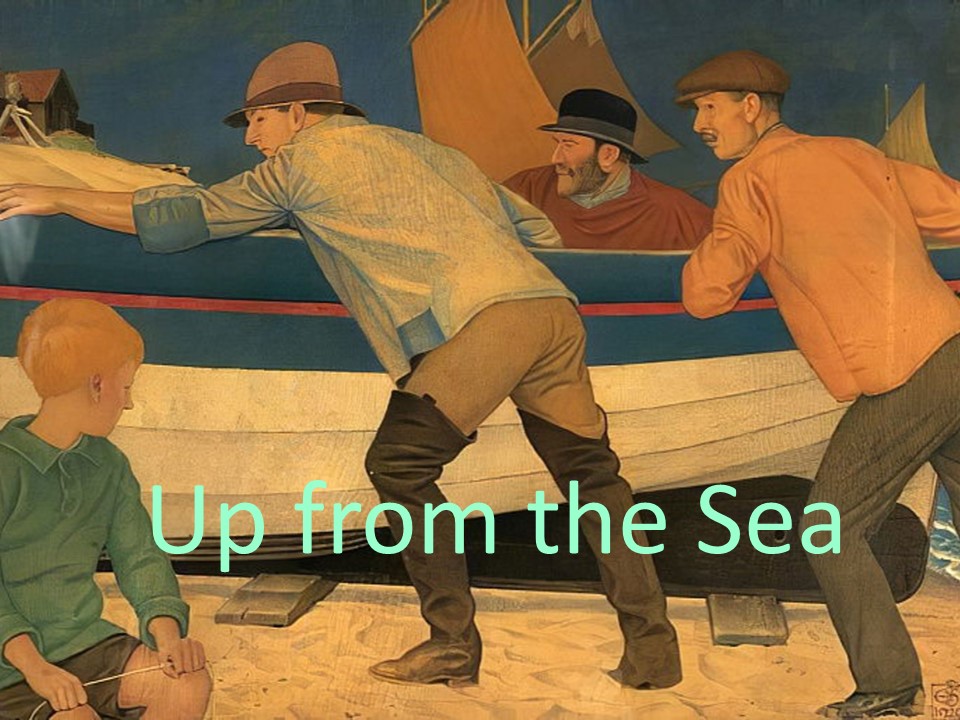 In April 2021 I presented one aspect of my work on the singing traditions from Southwold, in Suffolk for an online talk entitled Up from the Sea: Sea Songs from Southwold on the Suffolk Coast.
In April 2021 I presented one aspect of my work on the singing traditions from Southwold, in Suffolk for an online talk entitled Up from the Sea: Sea Songs from Southwold on the Suffolk Coast.
In that talk I focused on songs about the sea, and also touched on the role of visiting artists, musicians and writers, who were often inspired by the town’s fishing community, to see if they could reveal further information about vernacular singing.
I chose as my cover image this wonderful painting by Joseph Southall from 1920 – one of two similar studies. I particularly liked this one with the young boy looking on rather wistfully as the fishermen haul their boat up the beach.
In this present article I will elaborate a bit further on some of these little known visiting artists. The singers and songs are the subject of other posts mentioned at the foot of this page, where there is also a link to the afore-mentioned talk.
Joseph Southall (1861-1944)
I first became aware of Southall’s work through Ian Collins’ wonderful book Making Waves, published in 2005. This book is a marvellous survey, beautifully produced, of many artists who have been inspired by Southwold and its inhabitants.
Joseph Southall was brought up by radical Quakers in Edgbaston, Birmingham where he trained as an architect and attended art classes in the evening. He went on to be recognised as “one of the foremost tempera painters in the country and led to his participation in the exhibitions of the Arts and Crafts Exhibition Society and the exhibition of Modern Tempera at Leighton House, which immediately preceded the foundation of the Tempera Society, of which he became one of the leading members” according to Peyton Skipwith writing on The Victorian Web in 2005. Egg-based tempera is very durable, with a satin sheen finish and generally gives a strong opaque colour.
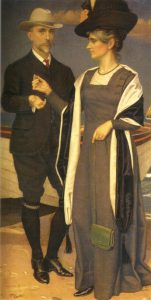 He fell in love with a first cousin, Anna Elizabeth Baker (known as Bessie), and because of their close kinship they delayed their marriage until they were both in their early 40s. Joe and Bessie first came to Southwold on their honeymoon in 1903 and spent weeks in the town every summer for most of the ensuing 34 years. He evidently found much inspiration in both the fishing fraternity and the fashionable holiday-makers, but Bessie was also involved, sewing the fabric paintings on to frames and applying numerous coats of gesso and size to finish the work. The Southalls also made their own egg-based paint and carved and gilded picture frames. Colour was of the utmost importance and no varnishing was allowed, although Goodall aimed to suffuse his images with a “golden hue”.
He fell in love with a first cousin, Anna Elizabeth Baker (known as Bessie), and because of their close kinship they delayed their marriage until they were both in their early 40s. Joe and Bessie first came to Southwold on their honeymoon in 1903 and spent weeks in the town every summer for most of the ensuing 34 years. He evidently found much inspiration in both the fishing fraternity and the fashionable holiday-makers, but Bessie was also involved, sewing the fabric paintings on to frames and applying numerous coats of gesso and size to finish the work. The Southalls also made their own egg-based paint and carved and gilded picture frames. Colour was of the utmost importance and no varnishing was allowed, although Goodall aimed to suffuse his images with a “golden hue”.
Ian Collins writes about this self-portrait of the Southalls: “This 1911 double portrait of the finely-dressed Southalls searching on Southwold beach for semi-precious stones is called ‘The Agate’. Now on long-term loan to the National Portrait Gallery, it formerly lodged in the ladies’ lavatory of a Birmingham department store – latterly hidden behind a mirror after complaints from customers.”
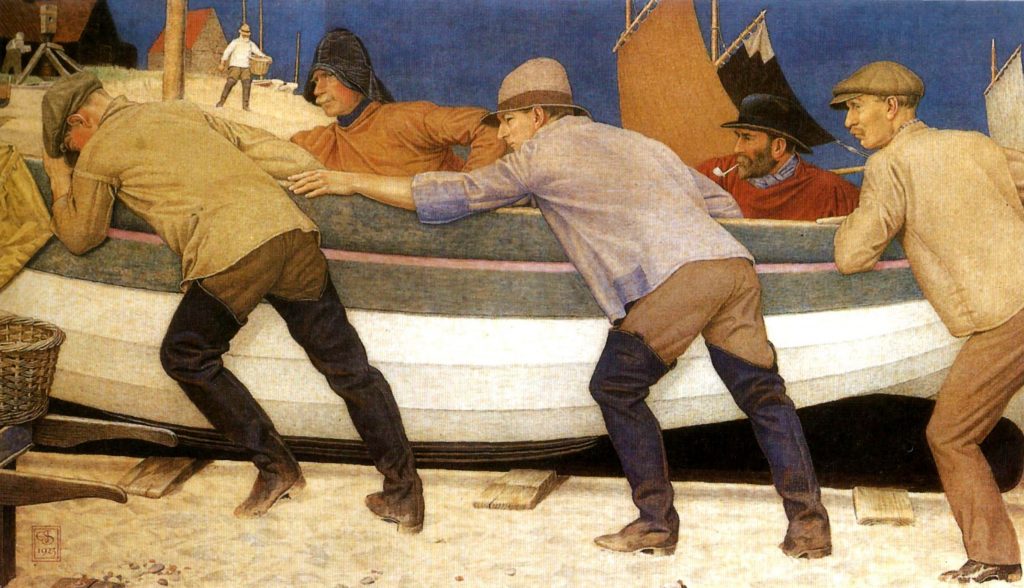
It is interesting to compare Up from the Sea with a later version of the same scene, entitled Fishermen and Boat (1923). In this later reworking, the little boy has gone, replaced with a basket and wooden barrow. The man in the brown smock has gained a clay pipe and an extra man, sporting a fine moustache and sou’wester has joined in to lend a hand, whilst a couple of fishermen have appeared in the background. Most striking of the additions, perhaps, is the young man on the left of the picture really putting his back into the effort and sporting, like the man in the middle, a fine pair of the long fisherman’s boots that were to prove fatal for some of those engaged in this dangerous industry.
My last two examples of Southall’s Southwold would seem to be the same elderly fisherman: The Old Fisherman leaning on his boat was painted during the Southalls’ honeymoon in 1903 and Fisherman Carrying a Sail dates from 1907. It isn’t known whether these were actual people, or composite creations from a variety of old “characters”, but they very much feel to be based on direct observations.
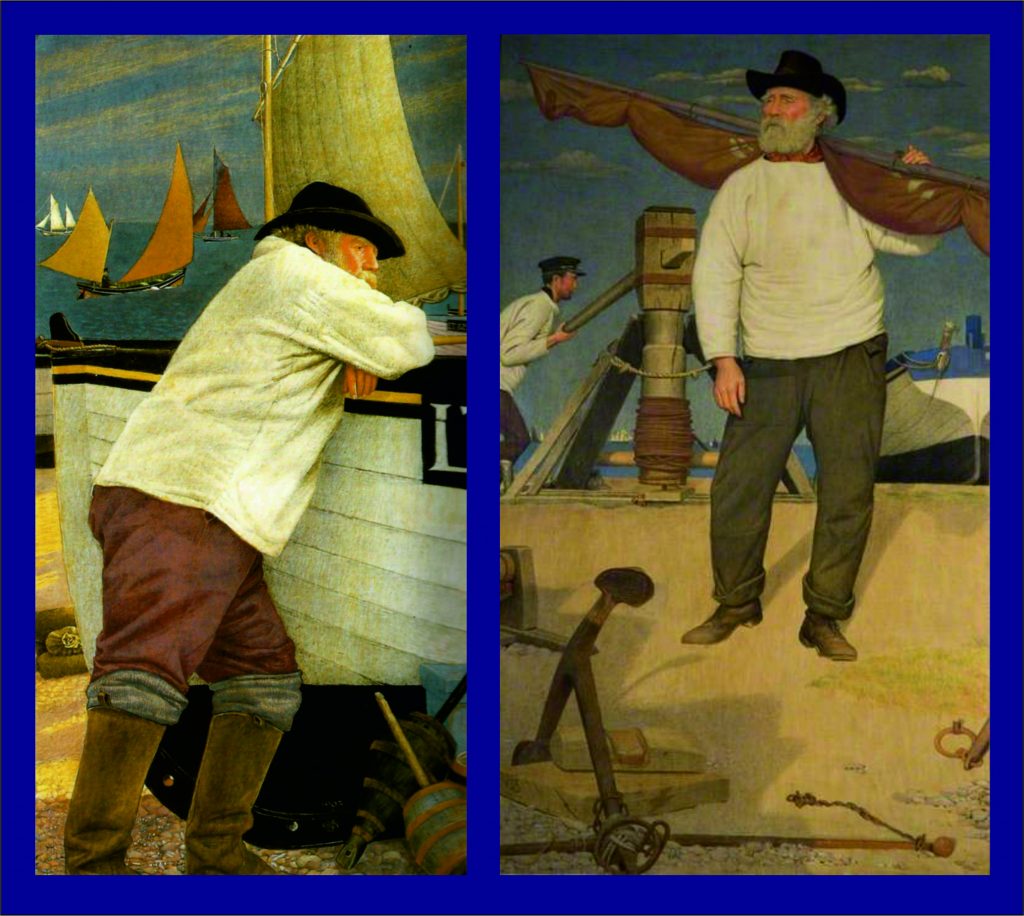 Southall’s images of holiday makers in Southwold show the changing fashions and habits in sea-bathing, and it is well worth browsing the internet where many more can be viewed.
Southall’s images of holiday makers in Southwold show the changing fashions and habits in sea-bathing, and it is well worth browsing the internet where many more can be viewed.
John Walter Georges (1879-1958)
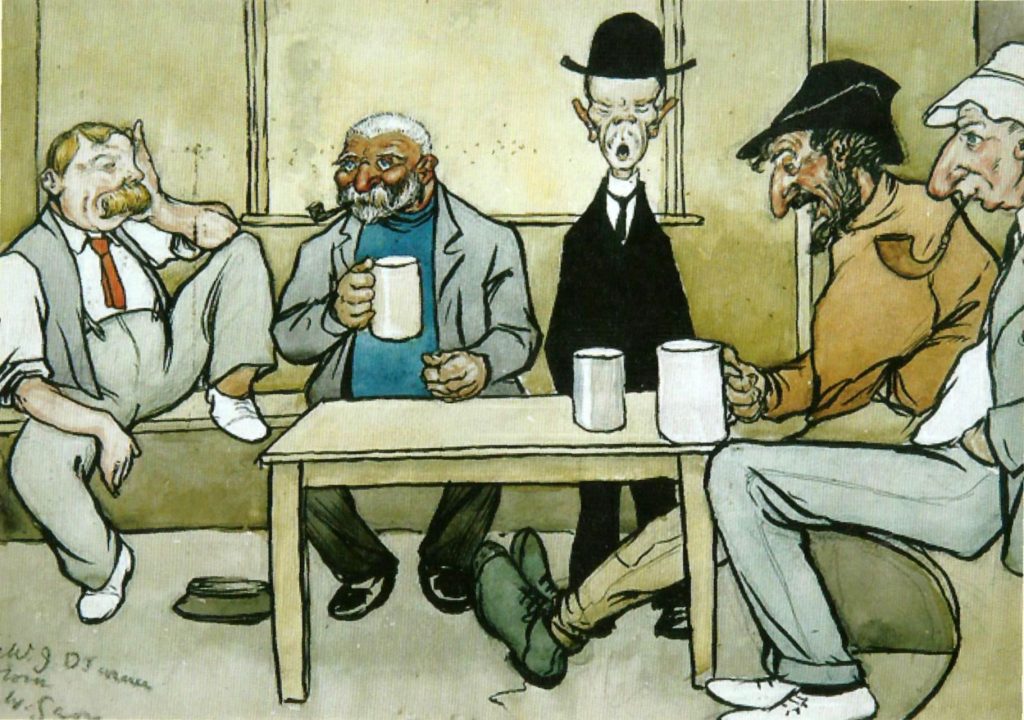
This singular work by J.W. Georges really captured my attention, as it features someone known to be a singer – Billy Rogers – apparently in full flow, in the Harbour Inn in 1911. It was also published in Making Waves and when the book was published in 2005, very little was known about the artist except that in 1930, when he executed this drawing, he was at St Martin’s School of Art in London, and living in Battersea Rise. Ian Collins noted that “The remembered figures, left to right, are landlord Charles James Prior, fisherman John Cannell of 3 Town Farm Cottages, North Road in Southwold (83 in 1930), ex-basketmaker W.M. Rogers (the blind son of ‘Old Dog’ Rogers), the late fisherman Henry Ladd and the artist himself.”
Billy Rogers was known as a singer around the Southwold pubs and his story is told in Tales from the Harbour Inn.
But what of the artist?
Internet searches revealed no other works by John Walter Georges, so all I know is what I’ve found in a painstaking hunt through the genealogical sources. He was born in Brighton in 1879, the son of Julius Georges, a drawing master. Julius’ parents were born in France and his father was also a drawing master. John Walter moved to Lambeth to take up an apprenticeship in electrical engraving. At the age of 21 he married his boss’s daughter and in 1901 he and his wife Kathleen were living with her parents. After a couple of short-term residences, they settled into a home in Altenburg Gardens in Battersea, and by the 1911 census Georges gave his occupation as artist and art teacher. He retired from teaching in 1934, when the couple moved out to Epsom in Surrey, and he died in Weymouth, Dorset in 1958. This drawing came up for sale in 2004 and is the only known piece by Georges and his only known connection to Southwold. However there are indications of an ongoing family connection in Suffolk. His brother Julius had married a Norfolk woman and in retirement they lived in Clare, in south Suffolk. And, quite tantalisingly, a 16 year-old Dora Georges was living in Walberswick in the summer of 1930 – she is mentioned in Orwell in Southwold: His Life and Writings in a Suffolk Town, by Ronald Binns published in 2018, but I cannot find out any more about her apart from a possible marriage locally in 1937.
It rather looks as if Georges’ 1911 description of himself as “artist and art teacher” was a bit optimistic on the “artist” side. I am grateful for the survival of this one small work of art and it would be nice to think there were some more of his drawings lurking somewhere, unrecognised!
Peter Henry Emerson (1856-1936)
The photographer P.H. Emerson is probably better known than the painters featured above, although he is generally associated with the Norfolk Broads, but his Southwold work from the mid 1880s is also superb.
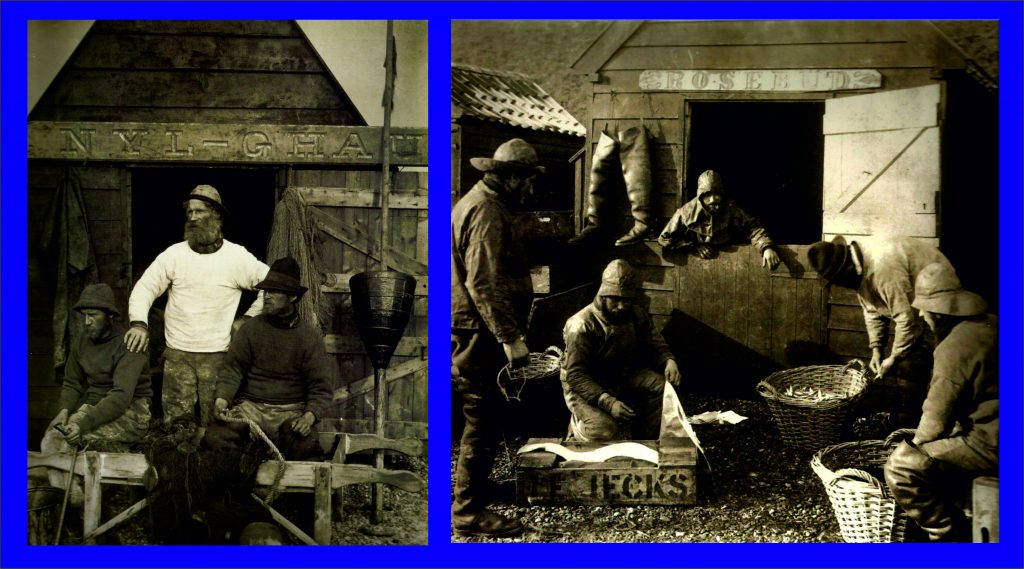
Emerson published his ground-breaking work in the 1880s in a series of limited edition books and destroyed the plates afterwards. The books, of course, now fetch thousands of pounds, but the photographs have been digitised – details of online holdings are at the foot of the page. His writing is also very interesting, but some of it is hard to access, although a couple of relevant books are available as reproductions or digital books.
Emerson had been born in Cuba, and lived in America until the age of 9. He trained as a surgeon, married and started family whilst still at Cambridge University. He and his wife and baby son first came to Southwold in the summer of 1883, when the Halesworth Times, which listed eminent visitors to the town, tells us they stayed at Mrs Scarll’s on the High Street. They were back as holidaymakers in 1884 and shortly afterwards moved into Wellesley House, from which address he applied for copyright on a photograph called The Hoer on 1st September 1885. The following year he abandoned medicine to pursue a career as an artist-photographer, and it is in this year, 1886, that most of his Southwold photographs were taken. Emerson led a bit of a peripatetic life thereafter, moving his family back to London in late 1886 and living for extended periods on houseboats on the Norfolk Broads, but nearly ten years later he did return to the area – to Oulton Broad – for a few more years, but by that time he was more interested in wildlife writing than photography.
A future article will cover Emerson in more depth, so I shall just include here some of his Southwold photos to which I can add some insights.
The two photographs above both show fishermen’s huts on the beach at Southwold, and both have names over the doorways. Geoffrey Munn in Southwold: An Earthly Paradise assumed that Rosebud was the name of the men’s boat, but I doubted that, as it looks like a name board off a boat itself. It turns out that no boat called the Rosebud was registered locally, but five years before Emerson took the photo in 1886, the following report appeared in the Diss Express on 25th November 1881, on the wreck of a brig registered in Hartlepool:
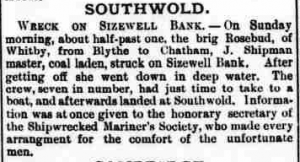 So after the crew had been rescued, the Southwold fishermen would have salvaged various remains – including this name board! Evidently this was not an uncommon practice as the following picture and information published in A Photographic Collection of Bygones by Barrett Jenkins indicate.
So after the crew had been rescued, the Southwold fishermen would have salvaged various remains – including this name board! Evidently this was not an uncommon practice as the following picture and information published in A Photographic Collection of Bygones by Barrett Jenkins indicate.
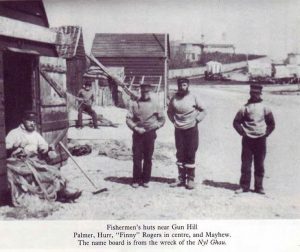 It is as well that Jenkins wrote the caption “The name board is from the wreck of the Nyl Ghau,” as it is not legible from the photo itself, but is clearly visible in Emerson’s photograph above.
It is as well that Jenkins wrote the caption “The name board is from the wreck of the Nyl Ghau,” as it is not legible from the photo itself, but is clearly visible in Emerson’s photograph above.

I’ve left the most interesting (for me anyway!) until last – a series of three interiors showing just how staged these never-the-less photos actually were. I loved the one with the fiddle and the boy dancing a Sailor’s Hornpipe or stepdance, and was quite amazed to find these other variations on the same theme.
All of these photographs are held in the Eastman Museum and are numbered 192 (fiddle), 107 (all seated) and 1 (spinning wheel) in their online archive (see below). While these are titled A Cottage Interior and thought to have been taken in Southwold, I have my suspicions that they may have been staged in a room in Emerson’s somewhat larger abode, where there would have been more room to fit in his large camera apparatus as well. Whether or not the fisherman on the left did actually play the fiddle, is not known, as we don’t know who he is. Emerson’s daughter Gladys was just a toddler when these photographs were taken, but in later life she became a professional violinist, so it seems likely Emerson’s household could have been musical enough to muster a violin amongst their possessions in 1886 when this photograph was taken.
There is evidence in Emerson’s writing of an interest in folksong, which will be covered in a future post.
Other articles about Southwold include Tales from the Harbour Inn, where there is more about Billy Rogers; and The Real Ben Hurr and MacKenzie’s Lambs and the Leg of Mutton which contain more about other singers.
Books
The book Making Waves: Artists in Southwold, by Ian Collins published by Black Dog Books in 2005, cannot be too highly recommended and is what sparked my researches into this particular aspect of traditional life in Southwold.
Southwold: An Earthly Paradise, by Geoffrey C. Munn, published by the Antique Collectors’ Club, 2006 contains beautiful reproductions of fifteen of P.H.Emerson’s Southwold photographs.
Shorelines: Voices of Southwold Fishermen, by Robert Jellicoe, published by Black Dog Books in 2021. Bob is the curator of the Southwold Museum and the archivist for the Sailors’ Reading Room and has been very supportive and helpful with my Southwold and P.H. Emerson related researches.
Orwell in Southwold: His Life and Writings in a Suffolk Town, by Ronald Binns published by Zoilus Press, 2018
Most of P. H. Emerson’s Southwold photographs were published in ‘Pictures From Life In Field And Fen’ (1887).
Online resources
The Victorian Web website has many gems including this biography of Joseph Southall.
The Suffolk Artists website is also good on Joseph Southall
The Eastman Museum has a wonderful collection of P.H. Emerson’s photos now archived on the Wayback Machine.
The British Library online archive also has a good selection – this link takes you to a search for “Peter Henry Emerson Southwold”
And lastly, here’s that link to my talk about singing traditions in Southwold.
Please note: Anyone wishing to cite this original research should credit it to Katie Howson and cite this website as the source. © Katie Howson, 2021.
Hello! I just read your brilliant work. I’d just like to say, that the paintings of the Southwold fishermen you mentioned, fisherman carrying a sail and the fella leaning over the boat is intact my Great Great Grandfather Rose Deal 🙂 He was a real person. How lucky am I?!
All the best, Paula
Hi Paula,
Amazingly, William ‘Rose’ Deal was also my Great, Great Grandfather. His son, ‘Prim’ was my Grandmother, Edith’s, father. Of course, you’re from the ‘White’ side of the family whereas my mum, Pam, married into one in London.